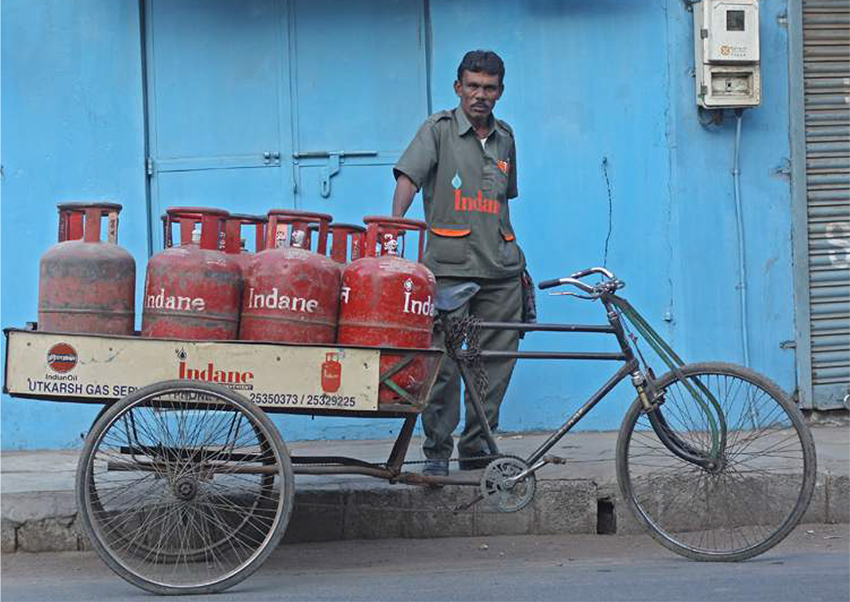Policy Brief
Rationalising Subsidies, Reaching the Underserved
Improving effectiveness of domestic LPG subsidy and distribution in India
Abhishek Jain, Shalu Agrawal, Karthik Ganesan
November 2014 | Energy Transitions
Suggested Citation: Jain, Abhishek, Shalu Agrawal, and Karthik Ganesan. 2014. Rationalising Subsidies, Reaching the Underserved: Improving Effectiveness of Domestic LPG Subsidy and Distribution in India. New Delhi: Council on Energy, Environment and Water.
Overview
This policy brief analyses the efficacy of the LPG subsidy in making clean cooking fuel affordable for households in India. It recommends appropriate reforms to rationalise the subsidy mechanism to meet the energy needs of the underserved population in the country. It also documents interventions that have been successful in raising awareness about clean cooking solutions among rural households.
In India’s 2011 Census, only 28.5 per cent of households reported using LPG as a primary fuel for cooking. Due to the poor penetration of LPG in rural areas, 80 per cent of the population at the time still used some form of traditional fuels for cooking and heating.
In January 2015, the Indian government launched a Direct Benefit Transfer scheme for LPG, to provide LPG subsidies directly into consumers’ bank accounts. An update on the status on clean cooking energy in India is provided in The Council’s flagship survey – the Access to Clean Cooking Energy and Electricity: Survey of States 2018.

Key Findings
- Import dependency for LPG had risen to 89 per cent on account of rising consumption of subsidised domestic LPG. The subsidy bill for FY 2013-14 stood at USD 8.96 Billion, constituting approximately four per cent of the non-planned expenditure of the budget that year.
- Despite more than 110 million connections in 2011, only 70 million households indicated using LPG as their primary cooking fuel.
- More than 50 per cent of the LPG subsidy was received by the richest 30 per cent of the Indian population, whereas the poorest 30 per cent received a meagre 15 per cent of the total subsidy disbursed.
- Urban areas had 70 per cent of total distributorships and 67 per cent of total connections.
- Less than half of urban households and only six per cent of rural households used LPG as their primary cooking fuel. The remaining 80 per cent of Indian households use some form of solid or liquid fuels for cooking due to lack of affordability, access, and awareness of LPG.
- The lowest income group spent eight per cent of their monthly expenditure on cooking energy compared to two per cent and 3.3 per cent by the highest income group in urban and rural areas respectively.
- A universal (and uniform) subsidy on LPG had resulted in low-income households spending a disproportionately high share of their income on cooking energy.
- The affordability limit for cooking energy expenditure, below which it can be termed as affordable, was 6 per cent of overall household expenditure. The LPG subsidy was not effective in delivering affordable cooking energy to the poorest households.
Key Recommendations
- Reduce the limit on subsidised LPG to nine cylinders per annum per connection. This will enable efficient usage while allowing fiscal space to increase the LPG user base.
- Classify the households with LPG connections into three categories - Below Poverty Line (BPL), Middle Income, and Well-to-Do, with each category receiving a differentiated level of subsidy support.
- Exclude the Well-to-Do category (top 15 percent of the population by income) from the LPG subsidy net.
- Improve LPG availability in far-flung rural areas by leveraging existing institutions such as Self-Help Groups (SHGs) and rural supply chains to deliver LPG.
- Establish uniform delivery charges per cylinder by pooling the transportation costs at the national level to reduce costs for rural customers and Oil Marketing Companies (OMCs).
- Raise awareness about the benefits of LPG consumption over traditional solid fuels, to create demand for LPG from sections which currently rely on alternatives.
There is need for a significant overhaul of the LPG subsidy regime to make clean cooking energy affordable as well as accessible for the underserved population, while keeping in mind the imperatives of fiscal discipline and national energy security.







